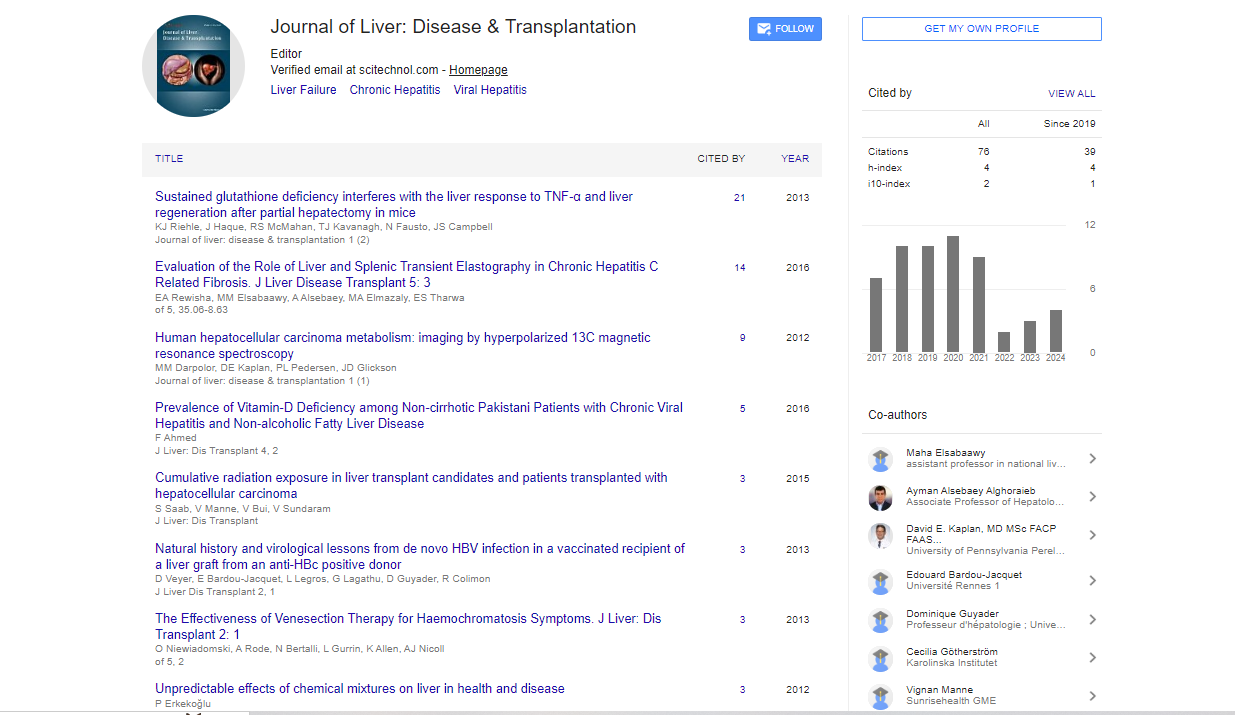Perspective, J Liver Disease Transplant Vol: 13 Issue: 3
Liver Transplantation Outcomes in Patients with Dual Hepatitis B and C Infections
Charlotte Garcia*
1Department of Hepatology, University of Berlin, Berlin, Germany
*Corresponding Author: Charlotte Garcia,
Department of Hepatology, University
of Berlin, Berlin, Germany
E-mail: charlotte.garcia@hu-berlin.de
Received date: 26 August, 2024, Manuscript No. JLDT-24-151924;
Editor assigned date: 28 August, 2024, PreQC No. JLDT-24-151924 (PQ);
Reviewed date: 11 September, 2024, QC No. JLDT-24-151924;
Revised date: 18 September, 2024, Manuscript No. JLDT-24-151924 (R);
Published date: 25 September, 2024, DOI: 10.4172/2325-9612.1000277
Citation: Garcia C (2024) Liver Transplantation Outcomes in Patients with Dual Hepatitis B and C Infections. J Liver Disease Transplant 13:3.
Description
Liver transplantation remains the final treatment for end stage liver disease, with Hepatitis B Virus (HBV) and Hepatitis C Virus (HCV) infections being among the most common causes necessitating the procedure. Patients with dual infection of HBV and HCV, although less common, present unique challenges in liver transplantation due to their increased susceptibility to cirrhosis, hepatocellular carcinoma and accelerated liver disease progression. Patients with both HBV and HCV infections are at an elevated risk of severe liver damage compared to those with single infections. Studies have shown that dual-infected individuals experience faster progression to cirrhosis and hepatocellular carcinoma, increasing the urgency for liver transplantation. The dual presence of HBV and HCV complicates pre and post-transplant management due to the complex interaction between the two viruses. In some cases, one virus may dominate over the other, affecting disease progression and response to treatment. These interactions can impact graft survival rates and lead to higher rates of post-transplant complications, such as fibrosing cholestatic hepatitis, a severe form of liver disease seen in immunosuppressed patients.
One of the major concerns in liver transplantation for HBV and HCV co-infected patients is the recurrence of viral infections in the transplanted liver. Re-infection of the graft by HBV or HCV can lead to graft dysfunction and eventually compromise patient survival. Generally, HCV recurrence is nearly universal after liver transplantation in HCV-positive patients, leading to rapid liver disease progression and lower graft survival rates. On the other hand, HBV recurrence can be reduced through the use of prophylactic antiviral therapies, such as Hepatitis B Immune Globulin (HBIG) and nucleotide analogs like entecavir and tenofovir. Patients with dual infection may have higher rates of graft loss due to the aggressive nature of HCV and the potential for HBV reactivation, particularly if antiviral therapy is not adequately managed. Studies indicate that posttransplant survival rates in dual-infected patients are generally lower compared to those with single HBV or HCV infections. A 2019 study found that five-year survival rates for HBV and HCV co-infected transplant recipients were approximately 60%, compared to higher rates observed in patients with single infections. This discrepancy underscores the need for targeted post-transplant care and vigilant antiviral therapy to improve outcomes for dual-infected patients.
The advent of effective antiviral therapies has significantly improved outcomes for liver transplant recipients with HBV and HCV infections. For HBV, long-term suppression using HBIG and potent nucleotide analogs has been effective in reducing recurrence rates. These therapies help maintain undetectable levels of HBV DNA, lowering the risk of graft infection and allowing for better graft survival. The combination of HBIG and oral antivirals is associated with a 90%-95% reduction in HBV recurrence post-transplant. For HCV, Direct-Acting Antivirals (DAAs) have revolutionized the management of post-transplant recurrence. DAAs have demonstrated high efficacy in achieving Sustained Virological Response (SVR), even in transplant recipients, effectively reducing the risk of HCVrelated graft damage. Studies have shown that treating HCV pretransplant or early post-transplant with DAAs can significantly improve survival rates and reduce the incidence of severe fibrosis in the graft. However, managing dual HBV and HCV infections requires balancing antiviral therapy to ensure both viruses are controlled without compromising liver function or amplifying the immunosuppression related risks.
Despite advancements in antiviral therapy, the management of liver transplant recipients with dual HBV and HCV infections remains complex. Immunosuppression post-transplant can lead to HBV reactivation, even in patients with undetectable HBV DNA levels pretransplant. There is also an elevated risk of DAA drug interactions with immunosuppressive agents, which necessitates careful monitoring and dose adjustments. Moreover, the cost of long-term antiviral therapy can be prohibitive for some patients, supporting the need for affordable and accessible treatment options. Future study should focus on optimizing immunosuppressive regimens for dual infected patients to minimize graft loss and adverse outcomes. Additionally, identifying biomarkers that can predict viral reactivation or disease progression in dual-infected patients could improve personalized treatment approaches. Ongoing studies into alternative therapies and prophylactic strategies could also hold promise for enhancing liver transplantation outcomes in this high-risk patient population.
Conclusion
Liver transplantation for patients with dual HBV and HCV infections is a high stakes procedure requiring tailored antiviral management to reduce the risks of viral recurrence and graft loss. Advances in antiviral therapies, particularly DAAs for HCV and nucleotide analogs for HBV, have improved outcomes but, dualinfected patients still face significant challenges. With focused study, targeted antiviral regimens and individualized care plans, the prognosis for dual-infected liver transplant recipients could continue to improve, offering them a better quality of life post-transplant.
 Spanish
Spanish  Chinese
Chinese  Russian
Russian  German
German  French
French  Japanese
Japanese  Portuguese
Portuguese  Hindi
Hindi 